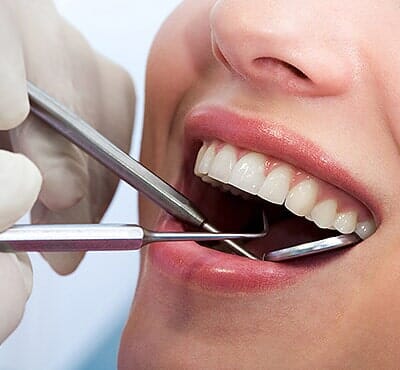Non-Surgical Gum Therapy in Fillmore, California
After a thorough periodontal screening
and examination you might need more aggressive therapies.
Gum Disease
Healthy gum tissue fits snugly around each tooth. It can be harmed by plaque, a sticky film of bacteria that forms on teeth and along the gum line. Bacteria in plaque create toxins that irritate gum tissue.
The early stage of periodontal disease is called gingivitis. Patients with gingivitis may experience gums that are red, swollen and bleed easily. The good news is that this early stage of periodontal disease is reversible.
However, if it's not treated promptly, it may lead to a more serious condition called periodontitis.

When plaque is not removed daily, it absorbs minerals found in saliva. The minerals form a rough, hardened material called calculus, or tartar. Once tartar sticks to the teeth, it can only be properly removed by a professional cleaning in the dental office.
Tartar that is not removed becomes a "plaque trap", holding more bacteria and making it difficult to keep teeth clean. Patients are encouraged to brush their teeth at least twice daily and floss or use an interdental cleaner once a day to help keep their mouths clean and healthy.
Surgical Gum Therapy
Some treatments for gum disease are surgical. Some examples are :
- Flap Surgery/Pocket Reduction Surgery :
During this procedure the gums are lifted back and the tartar is removed. In some cases, irregular surfaces of the damaged bone are smoothed to limit areas where disease-causing bacteria can hide. The gums are then replaced so that the tissue fits snugly around the tooth. This method reduces the size of the space between the gum and tooth, thereby decreasing the areas where harmful bacteria can grow and decreasing the chance of serious health problems associated with periodontal disease.
- Bone Grafts :
This procedure involves using fragments of your own bone, synthetic bone, or donated bone to replace bone destroyed by gum disease. The grafts serve as a platform for the regrowth of bone, which restores stability to teeth.
- Guided Tissue Regeneration :
Performed when the bone supporting your teeth has been destroyed, this procedure stimulates bone and gum tissue growth. Done in combination with flap surgery, a small piece of mesh-like fabric is inserted between the bone and gum tissue. This keeps the gum tissue from growing into the area where the bone should be, allowing the bone and connective tissue to regrow to better support the teeth.
- Bone Surgery :
Smooths shallow craters in the bone due to moderate and advanced bone loss. Following flap surgery, the bone around the tooth is reshaped to decrease the craters. This makes it harder for bacteria to collect and grow.
- Gingivectomy Or Gingivoplasty :
means excision of the gingiva. By removing the pocket wall, gingivectomy surgery provides visibility and accessibility for complete calculus removal and thorough smoothing of the roots, creating a favorable environment for gingival healing and restoration of a physiologic gingival contour.
- Crown Lengthening :
is a surgical procedure performed to expose a greater amount of tooth structure for the purpose of subsequently restoring the tooth prosthetically.

